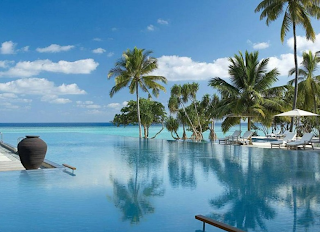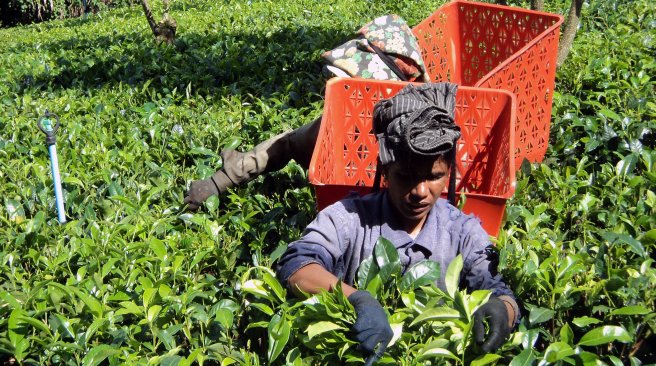Sri Lanka has always been well known for its high level of biodiversity and wildlife. It is rated as one of the world’s 34 biodiversity hot spots (Conservation International) and has the distinction of having established possibly the world’s earliest wild life reserves, when King Devanapiyatissa created a sanctuary in 3rd century BC, in the south of the country (Yala), where animals would be protected. (The National Atlas of Sri Lanka)
As identified, promulgated and administered by the Department of Wild Life Conservation (DWLC), Sri Lanka has currently 22 National Parks, which account for approximately 12 % of the land area of the entire country.
These parks, and the rest of the country, harbour an astonishing range of fauna and flora, many of them endemic to Sri Lanka. This includes over 4,000 species of flowering plants, 245 species of butterfly, 85 species of freshwater fish, 207 species of reptiles, 108 species of amphibians, 492 species of birds, 95 terrestrial species of mammals and several thousand invertebrates. (IUCN, 2011)
In addition, Sri Lanka boasts a wide and unique range of wild animal spectacles. It is the only place in the world that one can see the largest mammals, the whale, and elephant together in one single country. It has the world’s largest gathering of Asian elephants at Minneriya, now known internationally as ‘The Gathering’ (Lonely Planet); the largest concentration of leopards in the world in the area of Yala block 1 (Big Cat Diary BBC); and is one of the best places in the world to see blue whales, off the coast of Mirrisa in the deep south (The Telegraph, UK).
Not to be outdone by mammals, the avian aspects of Sri Lanka wildlife, though lesser known is also quite spectacular. Of the 400 odd species of birds, 32 are endemic to Sri Lanka, while the mixed bird species feeding flocks in the Sinharaja Virgin rainforest is said to be quite unique. (March for Conservation – Sri Lanka)
Given all these superlatives and varied fauna, it is worthwhile now perhaps to analyse some wildlife related tourism numbers.
Tourism statistics related to wildlifeAlthough Sri Lanka has 21 National Parks, only a handful are popular with foreign tourists. Yala takes pride of place followed by Horton Plains, Minneriya and Udawalawe National Parks. Interestingly the popularity is somewhat different when it is comes to Sri Lankan visitors, although Yala still takes top billing even among Sri Lankans.
From overall visitation statistics, a total of 638,098 Sri Lankans have visited all the wildlife parks in 2011, while the corresponding number of foreign tourists is only 198,536, which indicates that Sri Lankans outnumber the foreigners by almost three times.
However, the situation is entirely reversed when one considers the revenue earned. The wildlife parks earned approximately Rs. 301 m from foreigners for 2011, while the revenue from Sri Lankans was only Rs. 32 m, which means that the revenue earned from foreigners is about 10 times the revenue earned from Sri Lankans, due to the high disparity of the cost of tickets.
Further analysis of the visitation patterns to the two most popular wildlife parks indicate some interesting trends.
Foreign visitation to Yala has been steadily increasing, as in Minneriya. This could be attributed to Yala, of late, generating a renewed wave of interest because of the increasing sightings of leopard there. In the case of Minneriya, the increase in popularity is of course due to ‘The Gathering’.
Overall tourists’ interest in Sri Lanka’s wildlife
On an overall basis, these figures indicate that only a small fraction of tourists visiting Sri Lanka are enjoying the wildlife in our National Parks. In 2011 Sri Lanka recorded 855,975 arrivals, of which only 198,536 visited the National Parks, which is only 23%.
Kenya, which is one the world’s prime wildlife destinations, attracted almost 1.9 m visitors in 2011 and close upon 90% of them visit the national parks. Similar trends are evident in Botswana, Tanzania and South Africa.
Hence, in spite of having such a wide range of wildlife attractions in a very compact area in Sri Lanka, there aren’t many tourists who show interest in Sri Lankan wildlife. This lack of popularity could be attributed to several issues:
Lack of experiential facilities
Lack of infrastructure and convenience
Lack of branding and awareness
Lack of experiential facilities
The quality of interpretation and knowledge sharing in all the wildlife parks is woefully inadequate. Most of the trackers or rangers today are inexperienced new appointees, who do not have any deep rooted interest in wildlife. Hence all the visitors just go through a process of purely ‘spotting wildlife’. There is no enriching experience or proper interpretation of what is seen.
In countries like Costa Rica, guides are normally zoology or bioscience graduates, who have to go through intensive training on all aspects of wildlife and photography as well as communication skills.
There are no proper interpretation centres available, and the few that were set up through a grant in Yala, Minneriya and Udawalawe are not maintained, and most of the interactive exhibits are already broken.
Of late there is major overcrowding in national parks and unruly behaviour by jeep drivers, with scant respect being paid to the very animals who should be protected, resulting in great damage to the reputation of Sri Lanka’s wildlife parks.
Similarly, whale watching is also under threat due to unregulated operations, now perhaps beginning to disrupt the migratory patterns of the whales off the shores of Sri Lanka.
There seems to be little or no will, nor interest by the relevant authorities to control these situations, which are fast ‘killing the goose that lays the golden egg’.
Wildlife viewing should be a rich, rewarding, educational, and enriching experience. Sri Lanka does not provide this by any means, and therefore, we could be losing out due to this short coming.
Lack of infrastructure and convenience
All the wildlife parks lack conveniences for tourists and in most cases there aren’t even basic and acceptable toilet facilities.
There are already some concerns being raised by tour operators about the high entrance fees charged at the wildlife parks.
One must keep in mind that the rates charged currently (US$ 20-25) are in the same order as most other international parks. But the difference is that in other international parks, for the same price that is paid, there is excellent infrastructure facilities, quality guiding and interpretation services, so that the visitor get his money’s worth. This factor would also be making Sri Lankan wildlife parks non-competitive.
Branding and positioning
Certainly Sri Lanka can never aspire to be another ‘Kenya’. Kenya brands itself as a specialist wildlife destination and has earned that reputation over decades.
Although Sri Lanka certainly does have a plethora of wildlife attractions in a compact area, other destination attributes overshadow this position. Given the fact that Sri Lanka is a tropical island, with over 1,000 km of pristine beach, and given the overwhelming desire of tourists from the Western hemisphere who seek ‘sun and sand’ for their holidays, Sri Lanka will always be perceived primarily as a beach destination.
There have been many unsuccessful attempts to and promote Sri Lanka as a wildlife, nature or eco-tourism destination. A study conducted during the now defunct ‘Small Miracle’ branding exercise, clearly showed that the ‘top of the mind recall’ for Sri Lanka as a tourism destination was ‘sun and beach’.
Hence, it will be very difficult to completely change this perception. The current occupancy distribution pattern overwhelmingly reinforces that Sri Lanka is first and foremost a beach destination.
However, Sri Lanka scores heavily from its diverse tourism attractions. In addition to the beach, wildlife and nature will be a very close second offering, together with culture, adventure and wellness, which are also showing strong popularity.
Hence, as very correctly identified during the Sri Lanka Tourism branding exercise a few years back, the primary differentiation was the diversity and natural unspoilt beauty, within a small geographic spread.
It was from this that the excellent positioning statement for Sri Lanka Tourism was developed as ‘Asia’s Most Diverse Compact and Authentic Island’. This more or less sums up Sri Lanka’s positioning, with the beach always predominating, while the other attractive offerings of wildlife, nature, wellness, and adventure augment the core offering.
Wildlife as a sub brand
Hence, it is evident that if wildlife tourism in Sri Lanka is to be properly developed, it would have to be as a sub brand under the overall branding proposition. Already, there has been some progress been made in this area, albeit somewhat fragmented, with several ideas having been mooted.
- ‘Big Four’ Branding
In an effort to piggyback on the already well-established ‘Big Five’ brand of Africa (where sightings of leopard, elephant, buffalo, lion and rhinoceros are key features) it was felt that Sri Lanka would aspire to be the ‘Big Four’ brand (the elephant, whale, leopard and sloth bear). The author has been spearheading this concept for some time now.
- ‘Big Five’
In an effort to completely share the brand position of the African ‘Big Five,’ there have been efforts to brand Sri Lanka’s ‘Big Five’ as the leopard, elephant, bear, blue whale and sperm whale by Gehan D.S. Wijeratne, formally with Jetwing Group. However, this has caused some debate since two different sub species of a single animal (blue whale and sperm whale) have been included in the brand attributes.
- ‘Sri Lanka best for big game outside Africa’This is another effort, once again, to capture the already-established positioning in a prospect’s mind of Africa being the best choice for big game. So, next to Africa, why not Sri Lanka? This has been another one of Gehan’s ideas.
- ‘The Gathering’The unique phenomena of over 300 wild elephants congregating on the banks of Minneriya reservoir during the drought period from June to October each year has been Sri Lanka’s greatest success in wildlife sub branding.
It has today been accepted world over as ‘The Gathering’ and has been formally rated by the prestigious ‘Lonely Planet’ travel guide as the world’s sixth unique wildlife experience. This was originated by the writer and Gehan D.S. Wijeratne and was subsequently supported by many others.
Hence, the issue of creating a proper sub brand for Sri Lanka wildlife has been a lack of cohesive strategic plan and positioning, as it is evident from the above different ideas, which are mooted around with no cohesive strategy or plan to back it.
Even the success story of ‘The Gathering’ was achieved without too much strategy and planning. However, in this case, there was a unique phenomenon occurring on a regular basis, and it only needed consistent exposure to make it a success.
Conclusion
Therefore, it is quite evident that Sri Lanka can, and must carve out a niche for wildlife tourism to enhance the overall tourism offerings the destination can offer. However, like many other aspects, this requires strategic planning and execution across multiple ministries and agencies, which will be an immense challenge, given the rather disjointed administrative process that is currently prevailing.










































